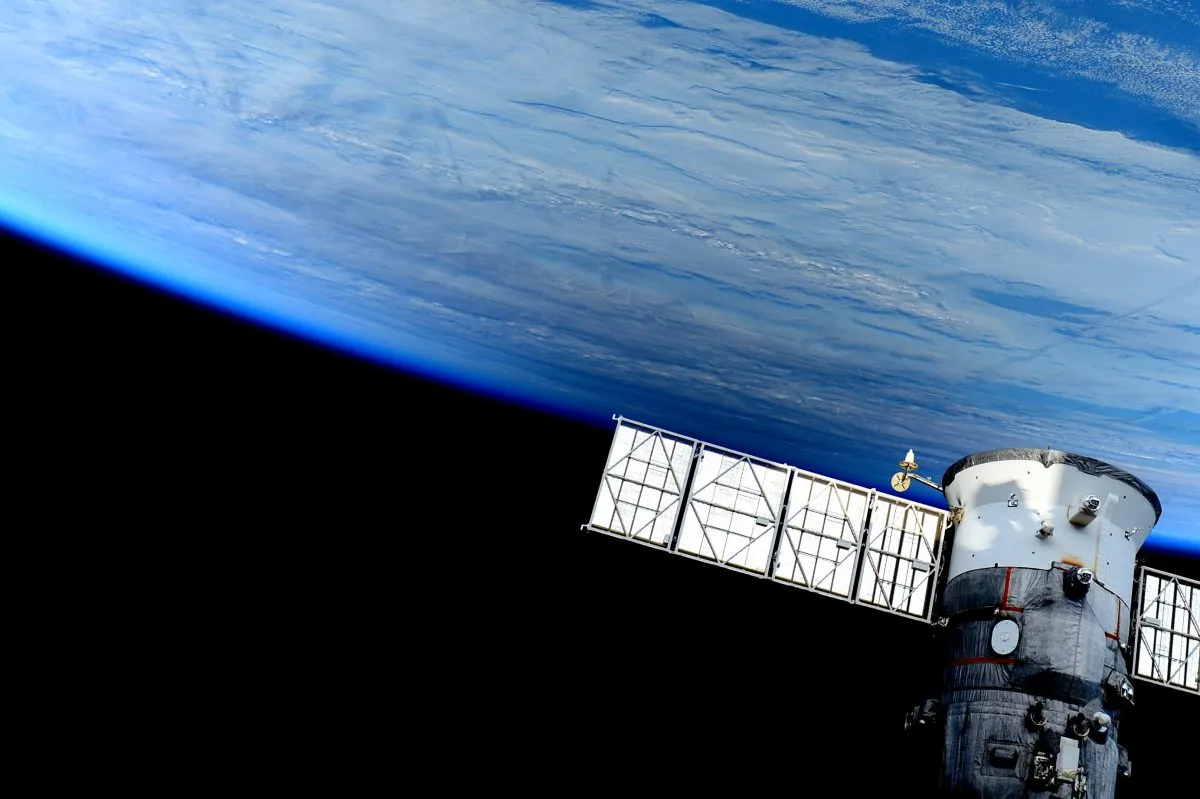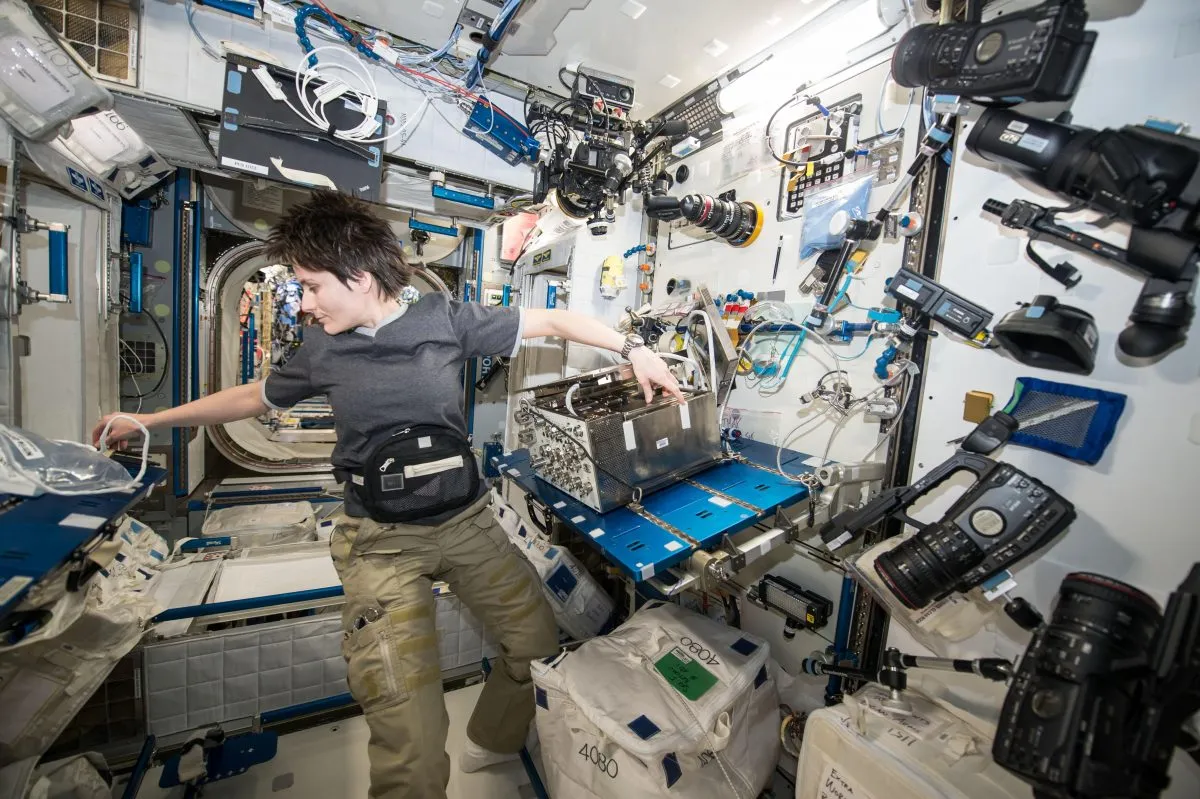Italian European Space Agency astronaut Samantha Cristoforetti spent 200 days in space between 23 November 2014 and her return to Earth on 11 June 2015, as part of her Futura mission.
At the time, Cristoforetti's stay on board the International Space Station was the longest single stay in space for a female astronaut, and throughout her time on the ISS the ESA astronaut had a packed schedule.
Cristoforetti undertook numerous studies to help scientists understand more about the physical and physiological effects of long-duration stays in space on the human body.

Read more about the International Space Station:
- What are the biggest dangers on the ISS?
- NASA astronaut Scott Kelly's Year in Space
- What do astronauts eat in space?
And during her stay on the ISS, the Italian astronaut also found time to brew the first ever espresso coffee in space and don a Star Trek costume as she stared out of the Space Station's Cupola window to the Universe beyond.
We got the chance to speak to Cristoforetti about her time living and working on the ISS, the scientific studies she was involved in, and her thoughts on getting human beings to Mars.

How does being on the ISS affect your perception of our home planet?
Being in space certainly blurs out the details and gives you an appreciation of the global scale.
Thinking about global problems, such as climate change, doesn’t require abstract thinking: the planet is right beneath you with its atmosphere, its ice caps, its oceans, its weather patterns.
We’re constantly embracing the entire Earth, one orbit every 90 minutes.
The idea that it’s one big system, that everything is interrelated becomes visually obvious.
It’s an immediate perception like that of your own body.

What side effects do astronauts experience in space?
In space your body experiences a lot of changes, although you’re not aware of them all.
About half of astronauts suffer from something called space adaptation syndrome, which is similar to being seasick and is caused by the disconnect between what you perceive and what your vestibular system is telling your brain.
Luckily, I didn’t feel sick but I did experience a pressure in my head for about a week.
This is brought on by the redistribution of bodily fluids towards the upper body and makes you feel congested.
Some astronauts feel like they have a cold for their entire stay.

How did your body cope returning to Earth after 200 days in space?
Space adaption is a lot easier because you’re moving from effort to effortlessness, but it’s the opposite on return as you’re going from this absolute lightness to carrying your own weight.
You feel incredibly heavy. Your brain has to re-learn how to estimate weight and you tend to not use enough force to move objects.
The first time I tried to walk after returning to Earth it felt like I was trying to balance a big rock on a couple of toothpicks! Fortunately, this only lasted for 24 hours.
Your cardiovascular system is also fatigued, as your heart and valves readapt to pumping blood around your body against gravity.
For the first few days back on Earth I felt tired and I had an elevated pulse, even at rest. I slept for 12 hours a day. It was my way of gauging that my cardiovascular system was still suffering.

How long was it before your body returned to normal?
We undergo tests before and after a spaceflight and this helps to determine if you’ve returned back to pre-flight condition. It took about 10 days for my vestibular system to normalise.
In terms of our muscles, we come back in good shape because we exercise a lot on the ISS.
However, we don’t tend to use our postural muscles in space, which help you to sit or stand up straight.
These muscles are typically difficult to train in a gym and so they shrink. From the moment you’re back you begin activating them again, so they return to normal after a few weeks.

What research did you do on the ISS?
I worked directly on roughly 50-60 experiments, both in the physical sciences domain such as combustion, fluid mechanics, material science, as well as in the life sciences.
The experiments that astronauts are most involved with are the human physiology ones, for which we serve as both the operators and the object of the observation.
I did research on sleep, on the cardiovascular system, on the immune response, on lung function, on balance and motor control, on bone health.In weightlessness, you destroy more bone mass than you build anew.

One experiment, called NATO (nanoparticle-based countermeasures for microgravity-induced osteoporosis), investigates whether it’s possible to maintain bone density by adding specific types of nanoparticles to bone cell cultures.
It’s not only for the purpose of long duration spaceflight, but also to see if it may be useful clinically.
Another investigated how the brain adapts to control balance and movement in the absence of a reference system.
For example, your feet on the ground send a signal to your brain on how to maintain balance, which you don’t have in space.
I had to repeat a series of movements with sensors attached to my body, and we were able to compare the results to a set of data I had completed before the mission.

Which did you find more thrilling, the journey to the ISS or the journey home?
I can’t really say, because both were unique experiences, physically and emotionally intense, but at the same time very different in terms of meaning.
Launch was the beginning of the adventure, it held the promise of those 6-7 months of extraterrestrial life.
The journey home was an amazing ride, falling back to Earth literally in a ball of fire, but there was also an undertone of melancholy about leaving the Space Station and wrapping up that amazing part of my life.
Are you scheduled to go back to the ISS any time soon?
There’s a tentative plan for me to go back in a couple of years, but the actual schedule depends on many variables, and especially on the full readiness of the new US space vehicles bringing crew to ISS: the SpaceX Crew Dragon and the Boeing Starliner.
Once they have completed their flight tests and become fully operational, it will be possible to have reliable crew rotation plans.
Of course I am following those developments very closely!

What are the challenges in getting humans back to the Moon or to Mars?
Astronauts will have to be well trained, because they will have to be more autonomous.On the ISS you can rely on almost real-time communication with an army of specialists on the ground who are there to troubleshoot and help you.
As you get further from Earth that’s going to become impractical very quickly.
If something goes wrong, astronauts will need to be able to solve the problem in a more autonomous way. They will need to be able to access a repository of knowledge and advanced automatic assistance to help them to troubleshoot any technical malfunctions.
The other issue is that there’s not much to do on the way. Astronauts will have to cope with a long journey on a spacecraft that is probably going to be small, because it’s expensive to send mass to Mars.
Nisha Beerjeraz-Hoyle is a science writer and journalist. She was speaking to European Space Agency astronaut Samantha Cristoforetti.
This interview originally appeared in the November 2020 issue of BBC Sky at Night Magazine.